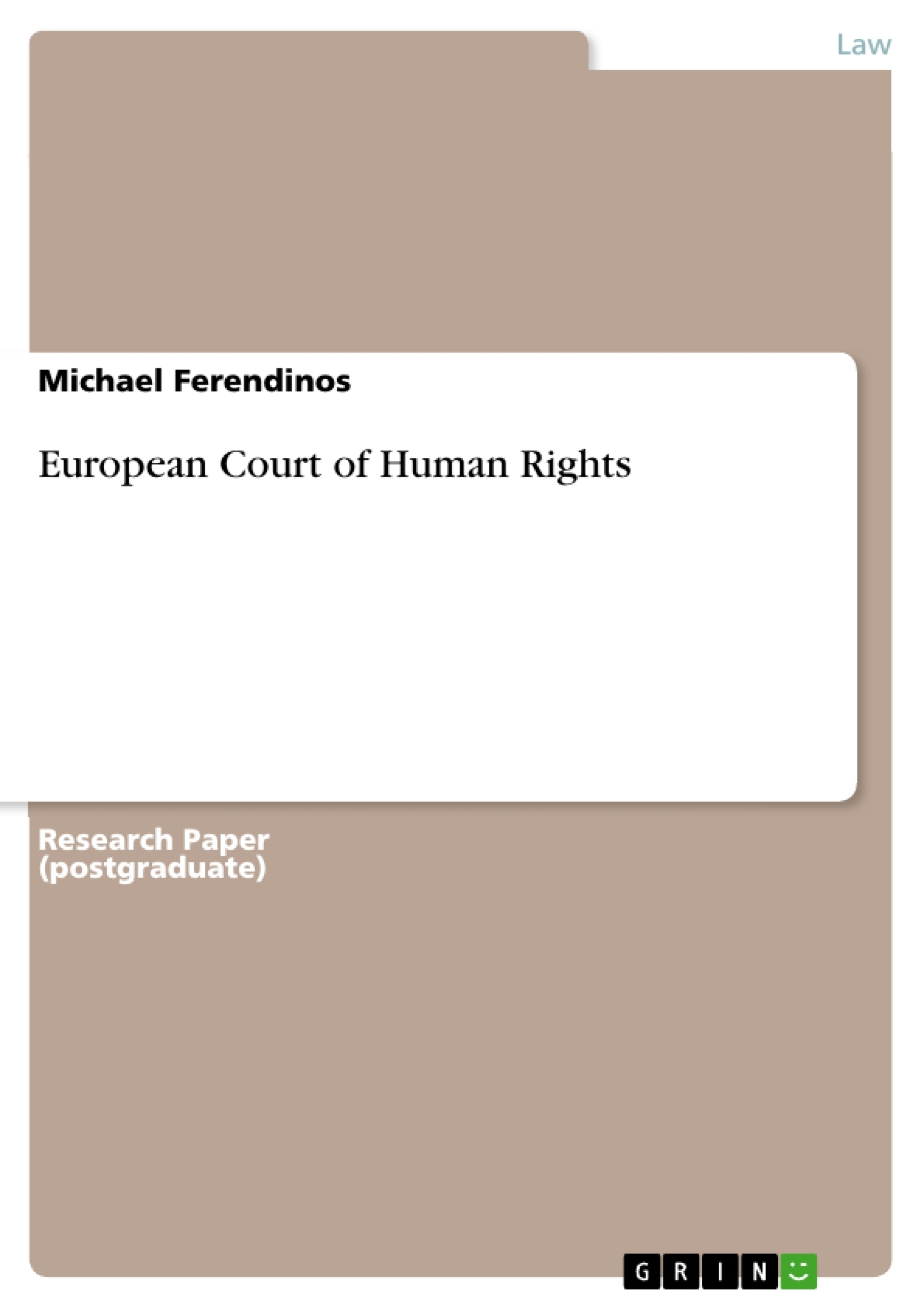
European Court of Human Rights
Forschungsarbeit, 2008
9 Seiten, Note: A
Jura - Europarecht, Völkerrecht, Internationales Privatrecht
Leseprobe
Inhaltsverzeichnis (Table of Contents)
- Introduction
- The Court
- Constituting treaty
- Mandate
- Functioning
- Composition and structure
- Procedure
- Effect on international law
- Case study: Cyprus v. Turkey
Zielsetzung und Themenschwerpunkte (Objectives and Key Themes)
This paper assesses the European Court of Human Rights' (ECHR) legal impact regionally and internationally. It provides an overview of the Court's functioning and analyzes its international influence, using a case study to illustrate its authority.
- The legal impact of the ECHR
- The functioning of the ECHR
- The international influence of the ECHR
- The ECHR's role in safeguarding human rights
- Analysis of the Cyprus v. Turkey case
Zusammenfassung der Kapitel (Chapter Summaries)
Introduction: This section introduces the paper's aim to assess the ECHR's legal impact and outlines the structure of the analysis.
The Court: This section details the ECHR's establishment in 1959, based on the Convention for the Protection of Human Rights and Fundamental Freedoms. It discusses the Court's mandate to implement and safeguard civil and political rights.
Constituting Treaty: This section explains the Convention's creation in 1950, its role in enforcing human rights, and the establishment of the European Commission of Human Rights, the European Court of Human Rights, and the Committee of Ministers.
Mandate: This section describes the ECHR's mandate to handle cases brought by individuals, organizations, and states against other states bound by the Convention, highlighting the evolution through various protocols, especially Protocol No. 11 and its impact on caseload management.
Functioning: This section explains the Court's functioning since the implementation of Protocol No. 11 in 1998, emphasizing its role in screening applications and the judicial nature of the Convention process.
Composition and structure: This section details the Court's composition of 46 judges, their election process, and the structure of sections and the Plenary Court's responsibilities.
Procedure: This section describes the Court's procedures, focusing on the roles of Chambers and the Grand Chamber in handling cases.
Schlüsselwörter (Keywords)
European Court of Human Rights (ECHR), international law, human rights, Convention for the Protection of Human Rights and Fundamental Freedoms, Protocol No. 11, case study, Cyprus v. Turkey, civil and political rights, regional and international impact, judicial procedure.
Details
- Titel
- European Court of Human Rights
- Hochschule
- Universität Stellenbosch
- Veranstaltung
- International Law
- Note
- A
- Autor
- M.A. Michael Ferendinos (Autor:in)
- Erscheinungsjahr
- 2008
- Seiten
- 9
- Katalognummer
- V122887
- ISBN (eBook)
- 9783640270101
- Dateigröße
- 343 KB
- Sprache
- Englisch
- Schlagworte
- European Court Human Rights International
- Produktsicherheit
- GRIN Publishing GmbH
- Preis (Ebook)
- US$ 6,99
- Arbeit zitieren
- M.A. Michael Ferendinos (Autor:in), 2008, European Court of Human Rights, München, Page::Imprint:: GRINVerlagOHG, https://www.diplomarbeiten24.de/document/122887
- Autor werden
- Ihre Optionen
- Vertriebskanäle
- Premium Services
- Autorenprofil
- Textarten und Formate
- Services für Verlage, Hochschulen, Unternehmen

- © GRIN Publishing GmbH.
- Alle Inhalte urheberrechtlich geschützt. Kopieren und verbreiten untersagt.
- info@grin.com
- AGB
- Open Publishing
Der GRIN Verlag hat sich seit 1998 auf die Veröffentlichung akademischer eBooks und Bücher spezialisiert. Der GRIN Verlag steht damit als erstes Unternehmen für User Generated Quality Content. Die Verlagsseiten GRIN.com, Hausarbeiten.de und Diplomarbeiten24 bieten für Hochschullehrer, Absolventen und Studenten die ideale Plattform, wissenschaftliche Texte wie Hausarbeiten, Referate, Bachelorarbeiten, Masterarbeiten, Diplomarbeiten, Dissertationen und wissenschaftliche Aufsätze einem breiten Publikum zu präsentieren.
Kostenfreie Veröffentlichung: Hausarbeit, Bachelorarbeit, Diplomarbeit, Dissertation, Masterarbeit, Interpretation oder Referat jetzt veröffentlichen!
- GRIN Verlag GmbH
-
- Nymphenburger Str. 86
- 80636
- Munich, Deutschland
- +49 89-550559-0
- +49 89-550559-10
- info@grin.com
-









